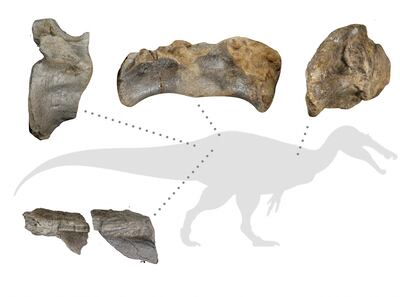The fossil of a 10-metre, crocodile-faced dinosaur that lived 125 million years ago and would have been Europe's largest land hunter has been discovered.
Several prehistoric bones belonging to the two-legged spinosaurid were discovered on the Isle of Wight off the south coast of England and have been analysed by scientists from the University of Southampton.
The spinosaurid would have weighed several tonnes and stalked lagoonal waters and sandflats in search of food during a period of rising sea levels. It is yet to be given a scientific name.
Dr Neil Gostling, corresponding author of the study published in the journal PeerJ, told The National it was an extremely exciting find.
"The specimen that we have here is really representative of what might be the largest known predator ever discovered in Europe," he said. "This material comes from an area which is starting to become much more marine and so it is unusual for us to find dinosaurs in these deposits."
The team found two new species of baryonychine spinosaurs in 2021 in another area of the island.

Regarding the latest find, he said they had found just a handful of bones but were able to identify small grooves along the top surface of the vertebra, which is indicative of a spinosaur.
The discovered bones of the ‘White Rock spinosaurid’ – named as such because of the geological layer in which the remains were found – include huge pelvic and tail vertebrae.
Thomas Richard Holtz, a vertebrate paleontologist from the University of Maryland not involved in the study, agreed that the new find "does seem to be larger" than a huge predator whose fossilised remains were discovered in Portugal.
Spinosaurids are known for their elongated heads. Rather than having the boxy skull of a Tyrannosaurus rex, their faces look more like that of a crocodile.
A leading theory to explain this trait is that they hunted on water as well as land.
"They're kind of like storks and herons, wading in and snatching fish from the surface," said PhD student Chris Barker, who led the study.
"It helps start to paint a picture of what animals were living in the time, which is a very poorly known part of English palaeontological heritage."
They were found by dinosaur hunter Nick Chase, who has since died, near Compton Chine, on the south-west coast of the Isle of Wight in the Vectis Formation geological structure and are now on display in the Dinosaur Isle Museum in Sandown.
Co-author Jeremy Lockwood, a PhD student at the University of Portsmouth and Natural History Museum, said Mr Chase was one of Britain’s most skilled dinosaur hunters. He dedicated his life to combing the beaches of the island for dinosaur remains.
He said: “I was searching for remains of this dinosaur with Nick and found a lump of pelvis with tunnels bored into it, each about the size of my index finger. We think they were caused by bone eating larvae of a type of scavenging beetle. It’s an interesting thought that this giant killer wound up becoming a meal for a host of giant insects”.
Mr Barker said Mr Chase's "uncanny ability" to find bones showed that "it's not just professional palaeontologists who are making impacts in the discipline".
The discovery "highlights the fact that collectors have a big role to play in modern palaeontology and their generosity helps move science forwards", he said.
And if there any aspiring fossil hunters hoping to pick up where Mr Chase left off, the palaeontologists would welcome more White Rock spinosaurid bones.
"We hope that a passerby might pick up some bits and donate them," Mr Barker said.





